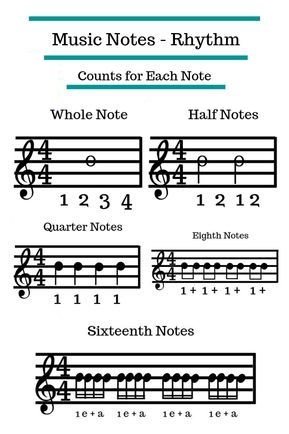Playing the piano is a captivating art that combines melody, harmony, and rhythm. While melody and harmony often take the spotlight, mastering rhythm patterns is equally crucial to creating a captivating musical experience. In this guide, we will explore the world of rhythm patterns for piano chords, providing you with insights and a helpful chart to enhance your playing.
Understanding Rhythm Patterns: Rhythm is the heartbeat of music, and incorporating diverse rhythm patterns into your piano chord progressions can elevate your playing to new heights. The key to mastering rhythm lies in understanding various note durations, rests, and their combinations.
Common Note Durations:
- Whole note (4 beats)
- Half note (2 beats)
- Quarter note (1 beat)
- Eighth note (1/2 beat)
- Sixteenth note (1/4 beat)
Basic Rhythm Patterns: Let’s start with some fundamental rhythm patterns to build a strong foundation:
- Straight Quarter Notes:
- C | G | Amin | F |
- Four-to-the-Floor Eighth Notes:
- C | G | Amin | F |
- Syncopation with Sixteenth Notes:
- C | G | Amin | F |

Advanced Rhythm Patterns: Now, let’s explore more intricate rhythm patterns to add flair to your piano playing:
- Swing Rhythm:
- C7 | F7 | G7 | C7 |
- [Swing Rhythm Graphic]
- Latin Groove with Syncopation:
- Dmin7 | G7 | Cmaj7 | F7 |
- [Latin Groove Graphic]
- Jazz Waltz:
- Dmin7 | G7 | Cmaj7 | Amin7 |
- [Jazz Waltz Graphic]
Experimenting with Dynamics: In addition to varied rhythm patterns, playing dynamics play a crucial role in creating a dynamic and expressive performance. Experiment with changes in volume, articulation, and tempo to breathe life into your piano chords.
Practical Tips for Mastery:
- Metronome Practice: Use a metronome to maintain a steady tempo while practicing different rhythm patterns.
- Slow Practice: Break down complex patterns and practice them at a slower tempo before gradually increasing the speed.
- Record Yourself: Recording your playing allows you to identify areas for improvement and track your progress.
Conclusion: Mastering rhythm patterns for piano chords is an exciting journey that can greatly enhance your musical expression. Use the provided chart as a starting point, and feel free to experiment with creating your own unique patterns. As you delve into the world of rhythm, remember that the key to excellence lies in consistent practice, patience, and a genuine passion for the music you create. Happy playing!
3 thoughts on “Mastering Rhythm Patterns for Piano Chords: A Comprehensive Guide”